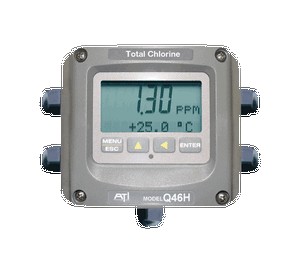Q46H/79S Total Chlorine Stripping Unit
Non-Contacting “Total Chlorine” Monitoring!
Chlorination of potable water, wastewater effluent, and industrial cooling water is widely used throughout the world to control biological activity in the water. Disinfection of potable water with chlorine ensures that tap water is safe to drink after passing through the distribution system piping. Wastewater disinfection helps to ensure that receiving streams are safe for recreational use, and cooling water chlorination reduces biofouling that can degrade heat transfer efficiency. This wide use of chlorination for disinfection purposes results in the need for a reliable “residual chlorine” analyzer that can operate in a variety of applications.
Residual chlorine is found in many chemical forms in water systems. Residuals in clean water are often predominantly free chlorine while wastewater and cooling water can contain mixtures of free chlorine, combined chlorine, and organochlorine species. Measurement of residual chlorine in applications where only free chlorine (potable water) or only combined chlorine (chloraminated water) exist can often be monitored with direct sensor measurement. However, applications where a variety of chlorine forms can exist (wastewater effluent and some cooling water) require a more complicated measurement method. These applications generally require a “Total Chlorine” measurement and involve chemically converting all chlorine species into a single chemical form. This is normally done by reacting the sample with pH 4 buffer and potassium iodide, where the various chlorine compounds convert iodine ion into molecular iodine.
Many on-line monitors for total chlorine use this iodometric method, often measuring the current between two exposed electrodes to determine iodine concentration. ATI’s Model Q46H/79S uses this same standard iodometric chemistry, but with a unique sensing technique for measuring the released iodine. The system takes the reacted sample containing iodine and uses an air-stripping system to remove molecular iodine from solution. The gas-phase iodine from the water sample is channeled through a conditioning module and then directly to an iodine gas sensor. The result is that the iodine measurement is made without any contact between the water sample and the sensor. Contaminants in the sample that cause fouling and contamination of standard electrodes do not affect the Q46 system, providing greater operational reliability.
A Gas-Phase Approach to Sulfide Measurement
The Q46H/79S Total Chlorine Monitor employs ATI’s Auto-Chem chemistry module to provide chemical treatment of the sample, air stripping of the released iodine, gas sample conditioning, and iodine gas measurement. In operation, a small amount of sample is pumped from an overflow assembly into the chemistry system and mixed with pH 4 buffer and potassium iodide (KI) solution. At pH 4, chlorine compounds in solution react as follows (equation shown for one chlorine compound only):
HOCl + 2Kl +H+
2KCl + I2 + H2O
The treated sample flows into an air-stripping chamber where a controlled amount of air removes the iodine from the water sample. The air coming from the top of the stripping chamber is directed to a gas conditioning module which removes any excess water and then to a flowcell containing the iodine gas sensor. The iodine gas sensor is an amperometric membraned sensor that generates current in proportion to the amount of iodine in the gas stream. Since the gas sensor is only in contact with clean air containing iodine, sensor fouling due to contaminants in the sample is eliminated.
Gas Phase Sensing
Measurement is made without contact between sample and sensor, eliminating the potential for sensor fouling.
Standard Method
Total Chlorine is measured using EPA recommended iodometric measurement after reaction of the sample with buffer and potassium iodide.
Analog Output Options
Two isolated 4-20mA outputs are standard. One output is programmable for PID function.
Chemistry Module Power Options
Power options include 115 or 230 VAC, 50/60 Hz.
Three Control Relays
Relays are programmable for setpoint, deadband, and time delay.
Digital Communications
Communication options for Profibus-DP, Modbus-RTU, or Ethernet-IP.
Clear Display
Back-lit large LCD display provides clear visibility in any lighting condition. A scrolling second line on the display provides additional information and programming prompts.
Two types of chlorine sensors are available. One is designed for flowcell installation, and the other is for submersion applications. Free chlorine monitoring should always be done using a flowcell system. Good control of sample flow and pressure is important for accurate measurement. The standard constant-head flowcell should be used for most applications. A sealed flowcell and a low-volume flowcell are also available for special applications. Consult your ATI representative for application assistance.
Submersible combined chlorine sensors can sometimes be used for measuring total chlorine in wastewater effluent. Wastewater effluents containing more than 1 PPM of ammonia, often result in a chlorine residual that is more than 90% monochloramine. Direct measurement with a submersible sensor can provide a dependable monitor without all the sampling and chemicals associated with total chlorine measurement.
Chlorine sensors, especially free chlorine, require up to 8 hours of stabilization time when first installed or after membrane change. ATI offers a battery powered “polarizer” that can be used to stabilize a spare sensor so it is ready to run within a few minutes of installation. Polarizers simply plug into the sensor connector and require no adjustments.


